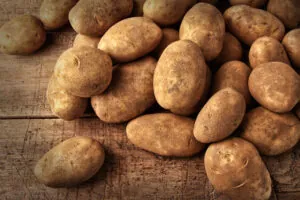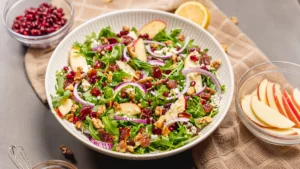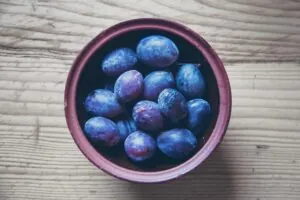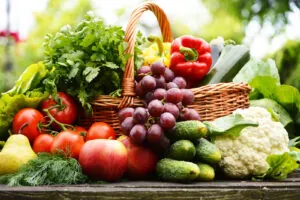Almonds Promote Gut Health
By Heide Kennedy, Arizona Farm Bureau Fill Your Plate Intern
Gut health is a topic that has been receiving a lot of attention lately, and as it should. Our gut health is crucial to our overall health. Since digestion occurs in the gut and is the process of breaking down the foods we eat into the nutrients that our bodies need in order to thrive, it is important that the gut be happy and healthy in order that the process of digesting and absorbing nutrients run as smoothly as possible. 
According to new research, the foods that we eat play a big role in the health of our gut. One such food that was shown to improve gut health was almonds. The study demonstrated that eating a handful of almonds a day significantly increased the amount of butyrate, which is one of the key microorganisms that live in our gut. Researchers said that increased butyrate leads to a strong gut lining, which ultimately promotes better nutrient absorption and flourishing gut microbes.
Eating foods that benefit our health is a great way to kill two birds with one stone. Not only are you meeting your energy needs for the day, but you’re also using those same calories to also nourish and promote other aspects of your health. Almonds aren’t the only food that promotes gut health. Check out the following articles from Fill Your Plate that discuss other foods that benefit our guts!
- Improving Gut Health Can Improve Overall Health – Fill Your Plate Blog
- Eat Black Eyed Peas For Gut Health – Fill Your Plate Blog
- Fermented Foods for Your Gut Health – Fill Your Plate Blog
- Something to Chew on: Gut Microbiome – Fill Your Plate Blog
- Give Your Gut what it Needs: Fiber – Fill Your Plate Blog
Sweet Potatoes Versus Regular Potatoes – Which is Healthier?
By Heide Kennedy, Arizona Farm Bureau Communications Intern
Forget the age-old debate of whether it’s pronounced po-tay-toe or po-tah-ta, how about which kind of potato has more to offer to our health? Sweet potatoes and regular potatoes are both super delicious and versatile and loved all over the world. Besides the fact that one is usually yellow or white inside, and the other is orange, and also that one is very plain flavored while the other is sweet, what are the nutrient differences between them, and which one is better? Let’s take a look at which spud takes the prize in terms of nutritional advantage.

According to registered dietician Beth Czerwony, sweet potatoes, and regular potatoes are both incredibly nutritious vegetables, and they actually have quite a few similarities, including that they are lower-calorie and low-fat foods. Both kinds of potatoes are also good sources of fiber, carbohydrates, potassium, vitamin B6, and vitamin C.
In terms of a side-by-side comparison of the two, sweet potatoes end up being just a slight bit healthier than regular potatoes, as they are slightly lower in calories, and are a better source of beta carotene and vitamin A. But that’s not to say that regular potatoes aren’t a nutritious choice. So, try alternating between the two, as it will add variety to your diet, and you’ll be able to reap the benefits of both!
Czerwony says that when cooking potatoes, baking is the best method, as you lose the least amount of nutrients this way. She also says to be mindful of the toppings that you put on, as this is an easy way to make that healthy potato not so healthy! And, to get the full amount of fiber that these potatoes offer, eat the skin as well!
So, pronounce “potato” however you’d like, and just remember to incorporate them into your diet, since both sweet and regular potatoes are chock full of nutrients! Not to mention, it’s pretty easy to find ways to use potatoes!
For recipes that use potatoes, check out the recipes page on the Fill Your Plate blog!
Take Care of Your Liver!
By Heide Kennedy, Arizona Farm Bureau Communications Intern
Many of us like to eat and drink certain things to improve the function of a certain part of the body. For example, eating probiotic-rich foods to promote gut health, or eating fiber-rich foods for your digestive tract. But how often do we think about eating to keep our liver healthy? 
This little organ does a lot for you, as it removes toxins from your blood which promotes digestion, functions as a storehouse for vitamins, and a whole lot more. Dr. Christina Lindenmeyer suggests the following 8 foods to give your liver a boost!
Coffee
It turns out that coffee can do more than just perk you up in the morning. Besides providing you with a caffeine boost, coffee can also lower the enzymes in your liver, which reduces any inflammation that might have been in your liver. Dr. Lindenmeyer notes that it is important that it be black coffee and not the super creamy and sugary kind.
Tea
For those who hate coffee, green tea can also promote liver health as well! The benefits of tea are similar to the benefits of coffee, as it also reduces inflammation in the liver.
Fish and chicken
Your liver also helps to process some of the macronutrients that you consume. Thus, Dr. Lindenmeyer notes that getting enough lean protein is important to fuel your liver so that it can produce some proteins that are important to your overall health.
Olives and olive oil
Olives are very rich in vitamin E as well as antioxidants, both of which your liver loves. Dr. Lindenmeyer says that olive oil raises your good cholesterol, which can help to prevent fatty liver disease, and not to mention, is good for your heart as well.
Nuts
Just like olives and olive oil, nuts have healthy cholesterol and vitamin E too. They are also very high in protein. Some suggested nuts include almonds, hazelnuts, pistachios, pine nuts, and pumpkin seeds.
Leafy vegetables
Your liver is in charge of blood clotting, and vitamin K plays a large role in this function. Leafy, green, vegetables are a great source of vitamin K. Dr. Lindenmeyer also notes that greens provide glutathione, an antioxidant that is good for your liver as well.
Berries
Just like leafy vegetables, coffee, and tea, berries provide a huge number of anti-inflammatory antioxidants. Dr. Lindenmeyer notes that blueberries are a great option.
Oatmeal
Oatmeal is a great source of fiber, which benefits your liver in a somewhat indirect way. All the fiber in that oatmeal is great for keeping you regular. This benefits your liver in that if you get too constipated, toxins begin to build up in the body.
So, in addition to eating to maintain the health of our guts, or digestive tracts, among many others, incorporating some foods to promote liver health is great too! What makes this even easier, is that a lot of the foods that promote liver health are also good for other organs or body functions as well!
For more health-related articles, check out the Fill Your Plate blog!
Kick That Sugar Craving!
By Heide Kennedy, Arizona Farm Bureau Communications Intern
Let’s be honest with ourselves. Every now and then, a sugary snack just hits the spot. Unfortunately, however, these sugary snacks are less than healthy, and sometimes that craving for some sweet goodness is just all too tempting. So, whether you’re trying to avoid sugar for a diet, or just to cut back on your overall sugar consumption, here are some tips to help you kick that craving when it hits. 
Pick a healthy snack
When that craving hits, resist the urge to grab a cookie, and instead make yourself a balanced snack that will satisfy your hunger and give you some nutrition. Registered dietician Anna Taylor says that when choosing a snack, it is vital that you pair a fiber-rich carbohydrate with a lean protein or a healthy fat. The reason for this is that carbs are digested fastest, so that will give you immediate energy, while proteins and fats are digested much slower, so those will give you lasting energy.
Drink lots of water
Often, when we feel hungry, we’re really just in need of some water. So, whenever you feel a craving hit, start by drinking a good amount of water and see how you feel. It is very important to be drinking enough water everyday anyways, so its beneficial either way.
Don’t skip meals
When you skip a meal or two, it usually leaves you feeling starving by the time your next meal rolls around. As a result, it will probably leave you with cravings and a more likely chance of overeating.
Purchase wisely while at the store
Next time you are grocery shopping, be mindful of what you buy. Try avoiding any of the sugary snacks or desserts that line some of the shelves and instead buy fruits and vegetables and other whole foods. If you don’t have sugar in your house, it makes it much harder to eat it!
So, whenever you begin to crave some ice cream, cookies, or brownies, try out some of these tips and see if they help you to reduce the amount of sugar that you consume!
For more articles on sugar, check out the Fill Your Plate blog!
Beets – A Vibrant and Healthy Veggie!
By Heide Kennedy, Arizona Farm Bureau Communications Intern
I absolutely LOVE vegetables. I’ll eat them raw, roasted, sautéed, grilled, and pretty much any way that they can be prepared. However, there is one vegetable that I’d rather not eat. That vegetable would be beets. While their color is gorgeous, to me they taste like dirt. But, as we all know, not all foods that are incredibly good for you actually taste appealing.

According to registered dietician Sarah Thomsen-Ferreria, “Beets are unique for their cardiovascular and heart health benefits. Due to a combination of compounds found in beets, they are able to enhance blood flow, improve the health of arteries, support lower homocysteine levels, and reduce LDL cholesterol.” Thanks to betalains, which are the compounds that give beets their gorgeous color, beets are an amazing source of anti-inflammatory antioxidants. Additionally, they are a great source of fiber, nitrates, and potassium, all while being low in calories!
If you’re like me, you’d love to reap the health benefits of eating beets, but you just can’t get over the dirty taste that they often have. Well, read on for some tips on how to prepare them deliciously!
- Add into salads and mix with other toppings
- Blend some into dips like hummus
- Add into a smoothie to mask the flavor
- Roast them
So, let’s not give up on beets entirely. Try out some of the preparation tips above and see if you can find a way to make these beautifully red veggies enjoyable to eat! Not only will you be adding variety to your diet, but you’ll also be getting a load of health benefits!
Looking for some recipes that use beets? Check out these from Fill Your Plate!
Spruce Up Your Salads!
By Heide Kennedy, Arizona Farm Bureau Communications Intern
Did you know that Yuma, Arizona is known as the lettuce capital of the world for a portion of the year? For five months out of each year, Yuma produces approximately 90 percent of the lettuce here in the United States and ships the vegetables all over the United States and Canada. In fact, 1,000 to 1,200 semi-truck loads of product are shipped out daily from Yuma during the peak of the leafy-greens harvest. And, Arizona families get this incredible product too! 
This is great news for salad lovers like me because it means that having access to locally-grown lettuce is incredibly easy! Not to mention, salads are the perfect meal when you want something that is light, but still delicious and nutritious! But the toppings that you put on your lettuce are what make or break the healthiness of that salad. Depending on the toppings that you choose, you can either have a complete, balanced meal, or a bowl of lettuce with a lot of unhealthy mix-ins. Below are some dietician-recommended salad topping ideas to spice up your salads and turn them into complete, nutritious meals!
When building a salad to make it a complete meal, it’s important to top it with foods that will provide you with necessary nutrients such as fats, carbohydrates, protein, and fiber. The following toppings are examples of each!
- Fresh and roasted vegetables
- Fresh and dried fruit
- Meats such as pork, beef, chicken, or seafood
- Cooked whole grains
- Nuts and seeds
- Beans
- Crushed tortilla chips
- Shredded cheese
- Hard-boiled eggs
- Fresh herbs
- Avocados
- Olives
- Salsa
- Oil and vinegar-based dressings
It is so much fun to experiment with different topping combinations, and not to mention, it is an easy way to get a lot of variety in your diet! So, head to your favorite grocery store or farmers market and pick up some Arizona-grown lettuce! Then, head home and build yourself and your family a healthy, nutritious salad using some of the topping ideas above, or some that you thought of yourself!
For more articles on salads, AZ-grown produce, or just on food in general, check out the Fill Your Plate blog!
Plums are Both Beautiful and Nutritious

By Heide Kennedy, Arizona Farm Bureau Communications Intern
What is filling your fruit bowl? For most people, it’s typically the standard fruits, like apples, bananas, pears, and maybe some little clementine oranges. But how often are plums featured on your countertop? These cute little purply-blue fruits are delicious both fresh and dried, and to make them even better, are chock full of health benefits! Let’s take a look at why you should incorporate them into your fruit bowl!
According to registered dietician Gaby Vaca-Flores, plums are full of essential vitamins, including vitamin C and vitamin E, are low in sugar, and thanks to their beautiful color, are a great source of anthocyanins. They are also a great source of fiber. Thanks to all of the vitamins, anthocyanins, and fiber that plums contain, they can aid your health in the following ways:
Keeping you regular
The fiber that plums contain makes them great for keeping you regular, Vaca-Flores also notes that plums are made of approximately 80 percent water, which also helps to keep everything flowing.
Keeping your blood sugar in check
Because they are low in sugar, you can eat plums without experiencing any major spike in blood sugar levels. In addition to not spiking blood sugar, Vaca-Flores says, “Plums also deliver a hormone called adiponectin, which can help with blood sugar balance.”
Keeping your heart healthy
Due to all the anthocyanins, consuming plums can also help to protect your heart health. Eating these anthocyanins, which are also antioxidants, can help to lower your risk of cardiovascular diseases!
With that being said, get some plums and try adding some diversity to your fruit bowl and your diet! Not only are they great for your health, but they are delicious too!
For more health-related articles, take a look at the Fill Your Plate blog!
Grapes are a Healthy Fruit to Snack On!
By Heide Kennedy, Arizona Farm Bureau Communications Intern
Whenever I visit my grandparents, there is always a bowl of grapes on the counter or in the fridge. And, at every family gathering at their house, the fruit trays that my grandma makes always have a huge pile of grapes on them, and rightfully so. Grapes are a delicious, sweet, and crunchy fruit that is perfect for snacking on, and as it turns out, are actually very healthy for you. Let’s take a look at the specific nutritional benefits of grapes!

In terms of nutrition, grapes are quite healthy, whether they be green, red, black, or pink in color. According to registered dietician Catherine Perez, grapes are a very rich source of vitamin K, B vitamins, fiber, potassium, and antioxidants. And there are only about 69 calories in three-quarters of a cup of grapes!
Thanks to all of these nutrients that grapes contain, they provide the following health benefits.
- Promote healthy weight and blood sugar
- Promote heart health
- Contain anti-cancerous properties
- Strengthen the immune system
- Promote gut health
- Can protect your eyes
Grapes are a perfect snack, not only because they are healthy, but their small size and small clusters make them convenient and easy to grab and munch on! Besides being great for snacking all by themselves, some other unique ways to use grapes is to freeze them, char them, roast them, or pickle them!
Next time you’re at the grocery store, grab a bag or two of grapes and enjoy their health benefits and delicious, sweet and crisp taste!
Interested in some recipes that use grapes? Below are some tasty recipes from the Fill Your Plate blog:
Fill Up Your Plate with Veggies!
By Heide Kennedy, Arizona Farm Bureau Communications Intern
Growing up, my mom always had to fight my brothers and me about eating our vegetables. The three that we all absolutely hated with a passion were brussels sprouts, sweet potatoes, and mushrooms. But, despite our objections, we were always made to eat and finish what was put on our plate, veggies included. Now that we are all much older, we like our vegetables, and understand just how important they are to our health. The current Dietary Guidelines for Americans states advises that we be eating 2 ½ cups of vegetables every day. So, how can we ensure that we are getting that many in our diets? 
According to registered dietitian nutritionist Kari Gans, eating lots of vegetables is a great way to get a lot of essential vitamins, minerals, and fiber, while filling up a healthy plate and not adding too many extra calories. The following are some nutritionist-recommended veggies that are both highly nutritious and low in carbohydrates, making them perfect for filling you up and nourishing your body.
- Leafy greens
- Broccoli
- Zucchini
- Cauliflower
- Green beans
- Mushrooms
- Bell peppers
- Cucumbers
- Asparagus
- Celery
- Cabbage
- Avocado
- Brussels sprouts
- Beets
- Radishes
Each of these veggies is super easy to cook with, as they are very versatile. Also, many of these veggies are locally grown right here in Arizona! Next time you’re at the grocery store or at your local farmers market, keep an eye out for leafy greens, cabbage, broccoli, cauliflower, and more!
Looking for some delicious ways to use these veggies in the meals that you cook? The Fill Your Plate recipes page has a wide variety of recipes that use them! Check them out here!
5 Nutrients You May Not be Getting Enough of
By Heide Kennedy, Arizona Farm Bureau Communications Intern
Take a moment to assess your diet on a typical day. What is it usually comprised of? Is it eggs and toast for breakfast, a salad for lunch, and maybe a steak and some veggies for dinner? Or is it more like a muffin for breakfast, fast food for lunch, and pizza for dinner? While all these foods are similar in that they are delicious, they differ significantly in how nutritious they are. It is vital that we be getting good nutrition at each meal and not just consuming empty calories. 
According to the US Dietary Guidelines for Americans, there are 5 nutrients that are lacking from most Americans’ diets. These 5 nutrients include calcium, vitamin D, potassium, fiber, and iron. Registered dietician Emma Willingham says that each of these plays an important role in our health. Calcium and vitamin D are essential for building and maintaining strong bones, potassium is important for regulating the fluid levels in our cells, fiber is important for good gut health, and iron maintains blood health.
The reason that many don’t get enough of these nutrients is that when we eat lower quality meals that are highly processed, such as fast food, prepackaged food, or foods comprised of refined grains and sugar, we don’t get much nutrition because it has all been stripped out of these foods. So how can we make sure that we are getting enough of these nutrients in our diets? Simply eating lots of fruits, veggies, meats, dairy, and whole grains is a great way to ensure that you are getting enough of all these nutrients.
We all need to make sure we’re all avoiding empty calories and instead eating foods that help us to meet our daily nutrient needs! Next time you’re at the grocery store or local farmers market, stock up on some fresh produce, meats, and dairy so that you can prepare meals for yourself and your family that are full of nutrition! Make sure that you look for products that are produced right here in Arizona!
Whip Up a Brain-Boosting Breakfast!
By Heide Kennedy, Arizona Farm Bureau Communications Intern
What is your breakfast of choice? Cereal? Toast? Oatmeal? A muffin? Eggs and bacon? Breakfast burritos? Yogurt? Whatever food you choose to break your fast with, we can all agree that eating a healthy, balanced breakfast in the morning is pretty important. It gives you both nutrients and that little boost of energy to get your day started.

But, besides eating a balanced breakfast, it’s also important to eat for your brain health too. This helps to ensure that your brain is energized and able to focus on the day that is ahead. According to Dr. Austin Purlmutter, there are some key things to look for when making a brain-boosting breakfast.
Go For the Complex Carbs
First, it is important to eat complex carbohydrates as opposed to refined carbohydrates. The reason is twofold. Not only are complex carbs filled with nutrients and minerals that refined carbs don’t have, but complex carbs don’t produce that “energy crash” later in the morning. Some examples of complex carbohydrates include whole grains, fruits, veggies, yogurt, and legumes.
Increase the Fiber
Second, when making a brain-healthy breakfast, it is important to increase fiber and decrease added sugars. Dr. Purlmutter notes that approximately 70 percent of foods we find in the grocery store contain added sugars, with a significant amount of those foods being breakfast foods. This is easy to see, considering how many of the cereals in the cereal aisle are either chocolate or fruit flavored, and many breakfast pastries are basically just desserts disguised as breakfast.
Fiber, Protein and Fat
Finally, Dr. Purlmutter suggests incorporating three essential brain-healthy nutrients into each breakfast meal. These three are fiber, protein, and fat. He notes that these are a surefire way to ensure that you are full, fueled, and feeling great all day long.
Ready to make breakfast yet? Thanks to Arizona agriculture, we have access to a wide variety of locally grown and raised breakfast foods. Our local dairies provide us with milk, cheese, yogurts, and other dairy products, while Hickman’s gives us eggs! Not to mention all the ranchers who raise livestock for breakfast meats like sausage, bacon, and more! So, get yourself some locally grown ingredients, and whip up a brain-boosting breakfast for you and your family!
For more information on locally grown products, or for more health-related articles, check out the Fill Your Plate blog! Also, you can source for local agricultural products on Fill Your Plate’s “Find a Farm Product.”
Consider Incorporating Whole Grains into Your Diet
By Heide Kennedy, Arizona Farm Bureau Communications Intern
We often hear mixed opinions on whether or not we should be eating or limiting our intake of grains. Some popular diets like the paleo diet or the ketogenic diet stress the importance of abstaining from grains, even whole grains, while others, like the Mediterranean diet, tout their importance. This leads us to wonder, which view of grains is correct? An article published by Everyday Health breaks down what whole grains are and what they do for our health.

So, what are whole grains? Whole grains are grains that are in their natural state. They have not undergone processing that takes them out of this natural state, making them refined grains. According to registered dietician Dalina Soto, “Refining is a process where they remove the bran and nutrients in it, to create a flour that is easier to cook.” Some examples of whole grains include brown rice, whole-wheat flour, quinoa, wheat berries, and oats. Some examples of refined grains include white rice and white flour.
In terms of nutrition, unlike refined grains, whole grains are chock full of vitamins and minerals, such as thiamine, folate, niacin, magnesium, iron, and selenium. Whole grains are also a great source of fiber. But unfortunately, many of those nutrients are removed from the grain when it is refined.
Some of the potential health benefits of consuming more whole grains include:
- Reduced inflammation
- Lower risk of heart and cholesterol issues
- Type 2 diabetes
- Some cancers
- Obesity
It sounds to me like whole grains can actually be a good food to consume as part of a healthy diet. So, consider incorporating whole grains into the foods that you eat. This can be easy, as there are many whole-grain options for typical pantry staples like bread, crackers, and flour.
For more health-related articles, check out more on our Fill Your Plate blog!
Sunflower Seeds – A Tiny Yet Nutritious Snack!
By Heide Kennedy, Arizona Farm Bureau Communications Intern
Whenever my family and I go on road trips or to livestock shows, one snack that we usually always have with us is sunflower seeds. My brothers and I love trying all the different flavors of seeds that come in those little bags from the convenience stores, and so far, our two favorite flavors are dill pickle and black pepper.

Whether you like the flavored seeds or the plain and salted ones, there are a surprising number of health benefits packed into each little seed.
According to MindBodyGreen, sunflower seeds are a great source of vitamin E and antioxidants, fiber, and selenium, and they are also a great source of plant-based protein, containing about 5 grams per handful. Registered dieticians Abby Cannon and Molly Knudsen note that sunflower seeds also provide the following health benefits:
- Help to maintain healthy cholesterol levels
- Are a source of plant-based protein
- They keep your immune system healthy
- Help to reduce inflammation
Luckily, these little seeds are super versatile, so it’s easy to use them in different recipes and reap the health benefits that they offer. Obviously, you can snack on them by themselves, either plain or seasoned like my brothers and I do, or you can use them in various recipes. Toss them on top of salads or grain bowls for a crunchy topping. Or you can use them in place of pine nuts in pesto or mix them into granola or cereal. So, consider choosing sunflower seeds as a midday snack, or using them in your next recipe! They’re delicious!
Did you know that sunflower oil is also incredibly healthy? Check out this related article from Fill Your Plate!

